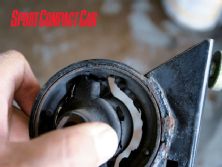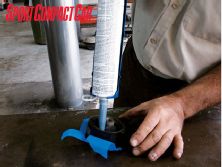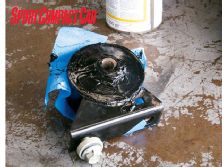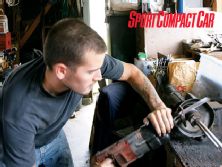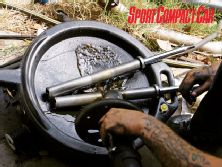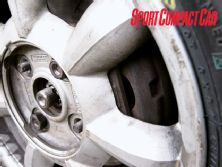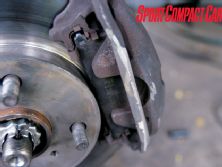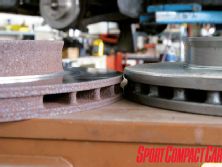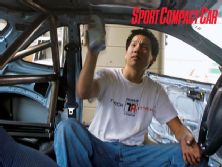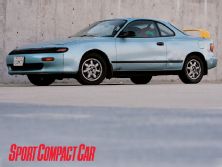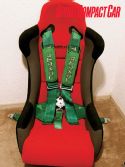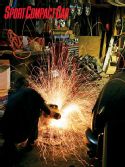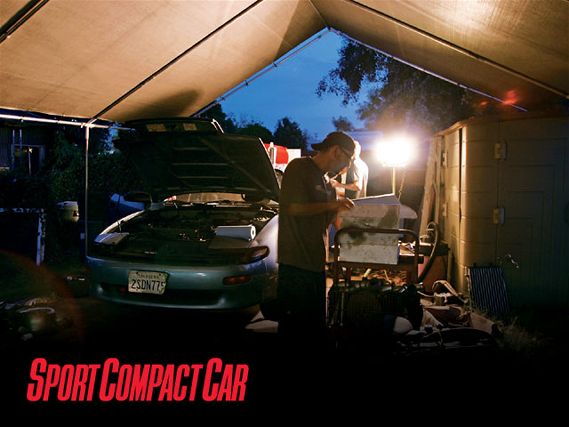 | Project Lemons - Toyota Celica
| Project Lemons - Toyota Celica
I didn't realize it back when I was still knee-deep in junked Celica parts, but there's a certain satisfaction from building a car that's going to be destroyed by a team of equally psychotic car nuts. Call it SCC team building.
With one week left to get Project Lemons ready for the 13-hour endurance demolition derby, we still had to resolve our drivetrain, suspension and brake issues. Plus get a roll cage worthy of this $500 beater race (see SCC, Feb 2007). So our mad panic continued at an even more frenzied pace. With the car already gutted, fluids changed and coolant hoses replaced, we took the car down to MD Automotive in Westminster, California, for some help with the heavy lifting.
At this point, we weren't quite sure how much more we had to tear into the car, but just on general inspection, we figured on a new clutch, CV joints, and some as-yet-undetermined bug in the brakes. The only way to tell was to put it on a lift and break out the impact wrench. Even though we had blown almost all the allotted $500 on just the car, we figured the judges wouldn't be able to tell if we replaced the clutch or a few other parts with OE items. Besides, we were sure everyone else was up to the same trick. So a new Exedy clutch and rebuilt axles were ordered and installed with the help of Mark Dibella at MD. The value of this lemon surprised us again when we inspected the flywheel and found that it didn't even need resurfacing.
Engine mountsWhile the tranny was out, we also realized the rubber in the front engine mount had ripped all the way through. In the spirit of SCC and the Lemons race, we just pulled the front and rear mounts that take the most engine motion and filled them with automotive window adhesive. With the help of a heat gun, the rubber had set enough to be mounted back in a matter of hours. It's a cheap but effective fix that also took out a lot of slop from the steering feel and made the car easier to throttle-steer on track. Like polyurethane engine mounts, the filled mounts do transfer significantly more vibration through the chassis and steering column, especially at lower revs.
Braking on the cheapNext to cooling, brakes matter most to a race car, even a slow one. With no idea what the conditions would be at Altamont Raceway, we took the safe route and fixed the brakes.
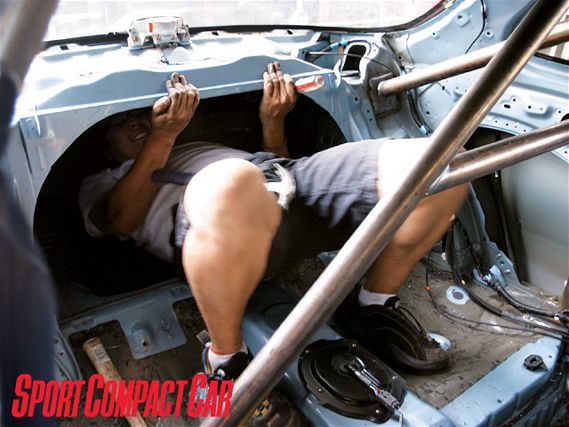 | The steel four-point roll bar was fabricated overnight by Alex Pfeiffer of Battle Version, attached to the floor near the B-pillar and stretched back to the rear wheel wells. We added only one harness bar onto the diagonal support, so we could throw in all the support gear.
| The steel four-point roll bar was fabricated overnight by Alex Pfeiffer of Battle Version, attached to the floor near the B-pillar and stretched back to the rear wheel wells. We added only one harness bar onto the diagonal support, so we could throw in all the support gear.
Again, the cheapness of the Celica ST was a welcome boon. The rear brakes were drums and no one makes aftermarket rotors or brake lines for this model. We didn't even bother replacing the shoes, since all the bias is up front. From our desperate calls to sponsors for inconspicuous aftermarket performance parts, the guys at Powerslot provided pads from its corporate partners, Hawk brakes. We got two sets-one for each day- of Hawk HP Plus pads, the best compromise between street and mild track use in terms of rotor wear. Although Hawk offers full race pads (like the Blues), they might have upset the brake balance too severely and possibly sacrificed overall stopping ability, since the front tires would do all the work.
To save costs, we tried to salvage the original rotors by turning them down. But the warping was so severe that by the time we finally got them flat, there wasn't enough material to keep them from warping again come race day. We decided to fit a new set of rotors and kept the old ones as back-ups. The entire system was also flushed out with Motul RBF600 synthetic DOT 4 brake fluid, which we've found to work well under repeated track beating. One squishy brake pedal run around the block told us the master cylinder was dead too, so that was replaced.
Overnight Roll CageThe organizers of the Lemons race were smart enough to separate safety equipment, brakes and tires from the original cost of the car. But while we had leeway to build an 800-point demolition survival cage-we only had one day budgeted to come up with the safest rollover protection we could find.
Unsurprisingly, no one in their right mind was up to taking this job, except one of the craziest, yet most reliable fabricators we know: Alex Pfeiffer of Battle Version. We sent the car to G-Dimension in City of Industry, California, where Pfeiffer and his welder are based, and asked for a six- to eight-point roll bar that tied into the door bars and rear shock tower supports.
Overhead hoops were omitted, since I didn't want to wear a helmet for the six-hour drive to the track. Pfeiffer looked the car over, grabbed the keys and with the demented grin of a mad scientist, shooed us away, declaring: "It'll be ready tomorrow before lunch."
When we returned, we found he only had time for a basic MIG welded four-point roll bar that anchored into the floor by the B-pillars and the rear wheel wells, which for an overnight job is still pretty good. With the impending time constraints and having no idea that the race was more demolition than endurance, we thanked him and ran to McKay's.
McKay EngineeringOur final weekend was spent trying to install a bucket seat and rails, safety harness, fire extinguisher, suspension, wheels and tires. We just didn't have a shop and a welder to press-gang. So we headed off to fellow magazine tech editor Ryan McKay's house, or McKay Engineering, as we fondly referred to it. It's a hole in the wall driveway, with an awning for cover and junk parts strewn everywhere for black widows to nest in. But it had what we needed, a household welder, chop saw and a leaky compressor for a cut-off wheel and grinder.
In our budget-oriented wisdom, we considered drilling a hole in the stock dampers and changing the original damping fluid with motor oil, which might have increased overall damping resistance. But spending the previous week in the car told us the fronts were completely blown, meaning the seals were probably done. So we 'found' a set of Koni Sport shock inserts, which, depending on how you interpreted Lemon rules, didn't add to the $500 tab as we scammed them for free from Koni.
Installation wasn't as easy as just bolting new hardware onto the chassis mounts. Since these were inserts, each spring and shock had to be disassembled, then gutted with a saw-zaw to remove the old internals. In the case of the rear shocks, the original housing had to be further modified to hold and secure the insert. Whatever yellow was left peeking out of the strut housing was spritzed with a shot of black rattle can to hide it from the judges. Just in case.
Even though we couldn't find springs in time, the twin-tube rebound-adjustable-only shocks were enough to transform the car from stripped-out crack-dealermobile to some semblance of a handling machine. The Koni's low-speed compression damping added hugely to controlling roll and pitch, and the rebound adjustment allowed us to tune ride and feedback feel. The rear damping was set higher to help the car rotate (which it did beautifully, intentionally or not) on track.
After digging in the bowels of McKay's backyard for an hour, we finally found the two sets of first-gen Miata wheels for which we had ordered our 205/55R14 Nitto NT-01s. All our online research seemed to show the two cars using the same offset and bolt pattern. But when the wheels were mounted, they didn't clear the calipers. Without longer studs, we weren't willing to fit spacers, so we resorted to grinding away at the cast iron caliper-something we don't recommend. Hoping it was only a reference surface for machining the caliper when it was made, we hastily ground off over 2mm of material from the face and bolted the wheels on. There was still minor contact, but the wheels spun and the calipers would cut the remaining grooves they needed into the softer aluminum wheels. We just had to remember to re-torque the wheels later.
In the meantime, others got to work on covering the hole where the sunroof used to be and fabricating a seat bracket for the Buddy Club Racing bucket confiscated from team member Joey Leh's private collection. With no time to get the right parts, we resorted to riveting hardware-store plexiglass to the outside of the roof and spraying the inside with gray primer to avoid greenhouse temperatures. We were also lucky enough to find and re-install the rear-view mirror and driver-side sun visor from the pile of parts we had torn out earlier.
The final hurdle was the driver seat bracket and it was dark by this time. The hour spent trying to break the OE spot welds on the indestructible stock seat's rails came up fruitless. Plan B was to tack weld the aftermarket seat rails to the floor, but the leftover tar underneath kept catching fire. In the end, we built mounting supports and gussets out of thick-gauge scrap metal, which meant the rails would support the driver's weight, not a steel bracket. We knew this would be an issue, but our hope was that the Takata five-point race harness (which retails for more than the car) would do the life-saving, not the seat.
If we had to do it againThirteen hours of non-stop racing is a good way to establish how good a car you've built. To my surprise, Project Lemons not only survived the ordeal, it thrived-performing more reliably than I would have ever imagined. In retrospect, there was little we could have done to better prepare the car for its wide assortment of drivers. The tires and shocks made the difference and we ended up using the brakes only to change lines or avoid crashes. The car was great. All I could have asked for was a proper seat bracket, which wouldn't bend when you go into the tirewall, and a water bottle with a straw.

